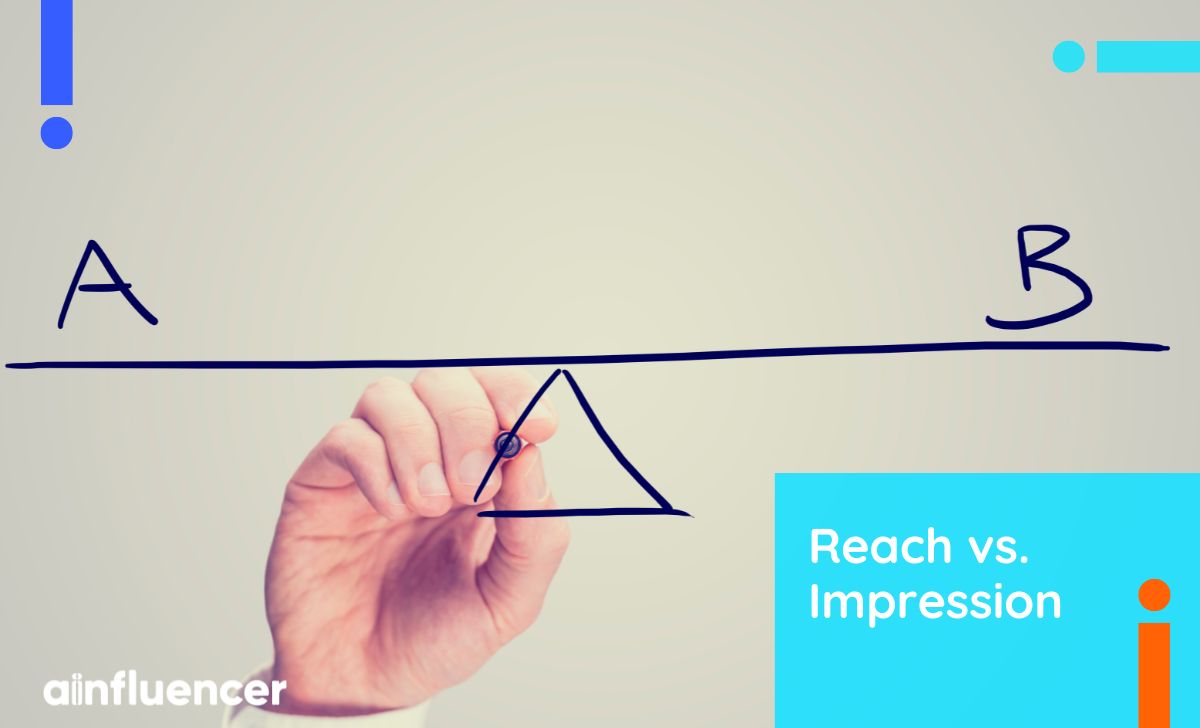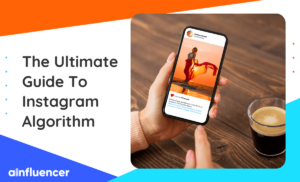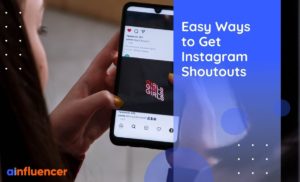Are you trying to boost your social media presence but need help on the difference between impression vs. reach? You’re not alone! Many business owners and influencers need help understanding how these metrics impact their success. In this guide, we’ll break down everything you need to know about the differences between reach vs. impressions on various social media platforms.
Knowing the difference between reach and impressions is important because it helps you connect better with your audience. If you understand these metrics, you can create content that either brings in more people (reach) or keeps your current followers more engaged (impressions). By focusing on the right metric, you can increase your brand awareness, boost Instagram engagement, and make your social media efforts more effective.
Enough talking. Let’s dive in and explore the differences between these two basic metrics and how they impact your business!
What’s the Difference Between Impression vs. Reach?
Reach and impressions are two key metrics in social media, but they measure different criteria. Here’s what these two metrics analyze:
Reach refers to the total number of unique individuals who see your content, while impressions count the total number of times your content is displayed for users, even if the same person sees it more than once.

So, think of reach as the number of different people who are exposed to your post, and impressions as the total number of times that post appears on someone’s screen.
Here’s an example: Let’s say you share a post, and eight different people see it. That means your reach is 8. Now, if three of those people see the post two times, your impressions would be 11. In this case, the reach is 8 because eight unique people saw your post. But there are 11 impressions because a few of them saw it twice.
Be careful: social media platforms use algorithms to decide who sees what, so not all your followers will see every post you create. This is why your reach might be smaller than expected, and why impressions tend to be higher because your content can show up multiple times for the same people.
It’s important to explore how each major platform defines and calculates these metrics to clarify the difference between reach and impressions. Now, let’s take a closer look at these social media metrics on different platforms.
Impression vs. Reach Differences Per Social Media Platforms
Different social media platforms emphasize certain metrics more than others. Some may provide basic information on reach and impressions, while others offer a more detailed breakdown.
To understand the difference between reach vs. impressions, it’s important to explore how each major platform defines and calculates these metrics.
#1 Impression vs Reach on Facebook
Reach on Facebook refers to the number of people who have seen your ads at least once. It’s important to note that this is an estimated metric, meaning Facebook uses sample data to make an educated guess. Because of this, the actual number can change as more data becomes available.
Reach is different from impressions. While reach counts the unique people who see your ad, impressions count the total number of times your ad is shown, even if the same person sees it multiple times.
However, reach and impressions don’t tell you how users interacted with your ad. To help you understand your ad performance better, Facebook divides reach and impressions into three categories:
1. Organic Reach vs. Impressions
This shows how many unique users saw your content or how many times your content was displayed without paid promotion. This is the result of your content naturally appearing in users’ feeds.
2. Paid Reach vs. Impressions
These are the results of your paid advertising efforts. For example, when you pay for Facebook Ads, the platform tracks how many people saw your ad and how many times it was displayed.
3. Viral Reach vs. Impressions
These occur when your content spreads beyond your immediate audience. When someone interacts with your post (like, comment, or share), their friends might see this activity, leading to additional reach and impressions.
Facebook further classifies reach and impressions into two types:
Served Reach vs. Impressions: This counts whenever an ad is delivered, regardless of whether the user actually saw it. The ad could be placed anywhere on the page, even where it’s unlikely to be noticed, yet it would still be counted.
Viewed Reach vs. Impressions: These are only counted when a user actually sees the ad. If the user leaves the page before the ad loads, it doesn’t count as an impression. This makes viewed impressions a more accurate measure of your ad’s effectiveness.
Instagram, similar to Facebook, also tracks impressions by counting how many times your content is seen, including multiple views from the same account. Let’s take a closer look at the differences between these two metrics:
#2 Impression vs Reach on Instagram
On Instagram, “reach” is the number of unique people who have seen your content, like posts or Stories, at least once. For Instagram Reels, reach means the number of people who have had the video show up on their screen, even if they didn’t watch it.
“Impressions” are the total number of times your content has been viewed, including repeated views by the same person. So, if someone watches your Reel multiple times, each time they view it counts as a separate impression.
#3 Impression vs Reach on YouTube
On YouTube, there’s no single way to measure how far your content reaches. In the YouTube Studio under the “Reach” tab, you can find different details like where you can find different details about where your traffic comes from such as videos suggested by YouTube, external websites, playlists, and more.
YouTube impressions count how many times your video’s thumbnail shows up on someone’s screen for at least 1 second. You can also check the impression click-through rate to see how often people clicked to watch your video after seeing your video thumbnail. Amazing, right?
#4 Impression vs Reach on TikTok
On TikTok, “reach” refers to how many different accounts have watched a video. This means that each unique account that views the video counts towards the reach. “Impressions,” on the other hand, count every time the video is viewed, even if the same account watches it multiple times.
So, impressions are the total number of views the video has received. It’s important to note that TikTok estimates the reach number, so it may not be completely accurate.
#5 Impression vs Reach on LinkedIn
LinkedIn doesn’t have a specific measure called “reach,” but you can check how many people viewed your profile in the last month. When it comes to impressions on LinkedIn, they refer to how many times your post, video, article, or update shows up in someone’s feed.
Even if users don’t interact with your content, it still counts as an impression. However, LinkedIn’s algorithm tends to show content more often if it gets a lot of likes, comments, reposts, and shares, which can lead to even more impressions.
#6 Impression vs Reach on X (Twitter)
The X app doesn’t measure how many people your post reaches, but it does keep track of impressions. Impressions are counted every time someone views your post on X. The impression count you see in the app shows how often your posts appear in someone’s feed or search results.
Why Are Reach And Impressions Important?
Marketers often use these metrics to measure how well their paid campaigns are doing. Reach helps you understand how many unique people are seeing your content. If more people see your content, it means your reach is higher.
If you notice that you have a high reach but not many conversions (people taking the desired action), it might mean that your campaign isn’t as effective as it could be. In this case, you should focus on targeting groups that are more likely to convert.
Impressions can quickly show if your content is working. If your ad isn’t getting many impressions, it might be a sign that you need to change the content so you don’t waste time and money.
Note: It’s important to focus on increasing your reach rather than just impressions. This helps you avoid showing your ad to the same people repeatedly.
What Is the Connection Between Reach & Impression to Your Marketing Strategy?
Understanding reach and impressions is important for connecting with your audience and improving your marketing efforts.
Key roles of Impressions & Reach on Your Strategy:
Know Your Target Audience
Growing your reach helps more people become aware of your brand, but it’s important to target the right people. Reaching a large number of people doesn’t help much if only a few are interested in what you offer. Create content that speaks directly to your target audience.
Monitor and Analyze Engagement
Impressions show how often your content is seen by people. If your impressions are increasing, it means your content is appearing more in people’s feeds. To boost impressions and reach, focus on creating content that people will want to share. Regularly track engagement to find and target potential customers, helping your strategy.
Which One Is More Important: Impression vs. Reach?
Deciding between impression and reach depends on your marketing goals. If you want to expand your audience, you should focus on reach, which measures how many unique people see your content.
On the other hand, if your goal is to connect more deeply with your current audience, impressions are key. Impressions track how often your content is viewed, even by the same person multiple times.
It’s important to look at both reach and impressions together, as they give you a fuller picture of how your campaigns are performing. If either number is low, it may indicate that your content isn’t performing well with your audience. In that case, making changes to your text, images, or calls to action can help boost these metrics and attract more potential customers.
To Wrap Things Up
By now, you understand the difference between Impression vs. reach on various platforms, you can use these metrics to see how well your brand is increasing awareness on social media. You’ve learned, that if you notice low numbers for reach and impressions, it could be a sign to analyze your content.
As you gain more insights about your target audience, you’ll be able to refine your marketing strategy by creating content that drives engagement and guides users through the sales process.
FAQs
Served Impressions: This refers to how many times your content is loaded on a web page or app. However, just because the content is loaded doesn’t mean it was seen by the user. For instance, your content might appear somewhere on a page, but if the user doesn’t scroll down to where it is, they won’t see it.
Viewable Impressions: This refers to the number of times your content was at least 50% visible on the user’s screen. It’s important to note that even if an ad is considered “viewable,” it doesn’t guarantee the user noticed or engaged with it.
Viral reach is the number of people who see your content because others share it. It’s a part of organic reach, but it’s special because it shows how your content spreads through other people’s networks. For instance, if one of your followers shares your video and 50 people who don’t follow you see it, those 50 people are included in your viral reach.
Reach shows how many different people saw your content. Impressions show how many times your content was seen, even if it was by the same person more than once. Different platforms might use these terms a bit differently.
If impressions are higher than reach, it means people are seeing your content more than once. This is a good sign because it shows your content is grabbing their attention.
Clicks count how many times people clicked on your post or link, which shows interaction. Reach counts how many people saw your content on their screen, regardless of whether they interacted with it.


![Read more about the article What to Post on Instagram? [10 Best Instagram Post Ideas in 2024]](https://blog.ainfluencer.com/wp-content/uploads/2024/02/Instagram-post-ideas-1-300x182.jpg)






